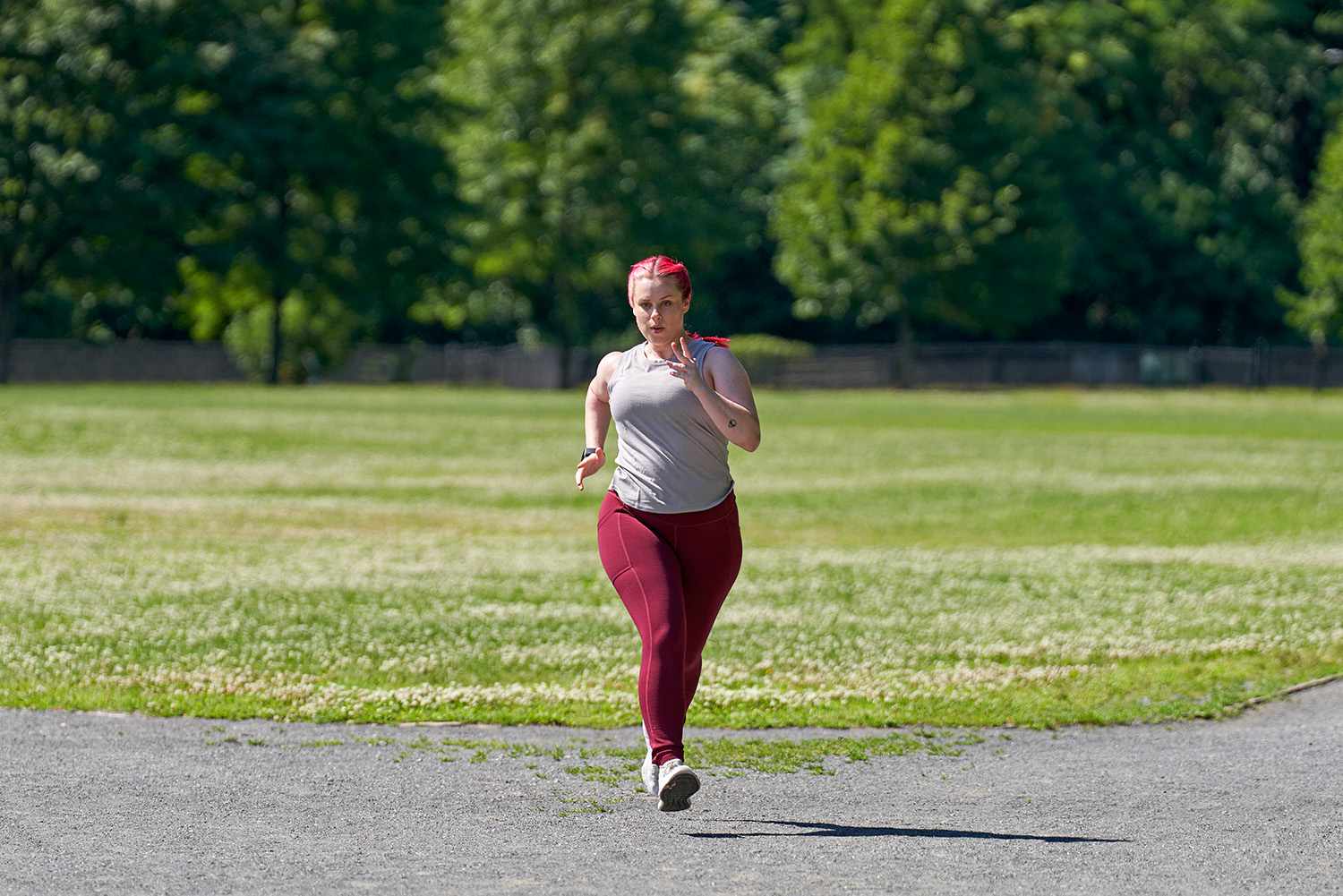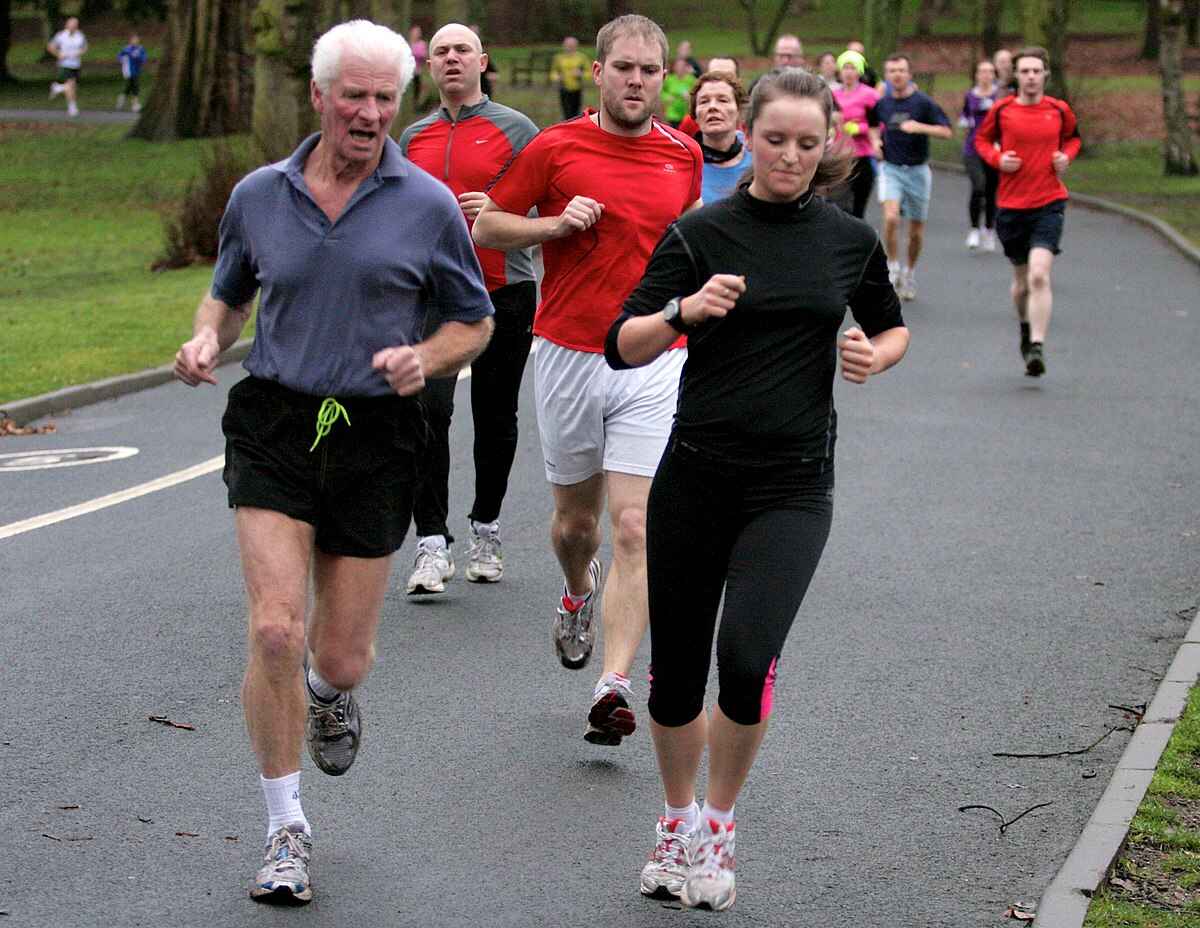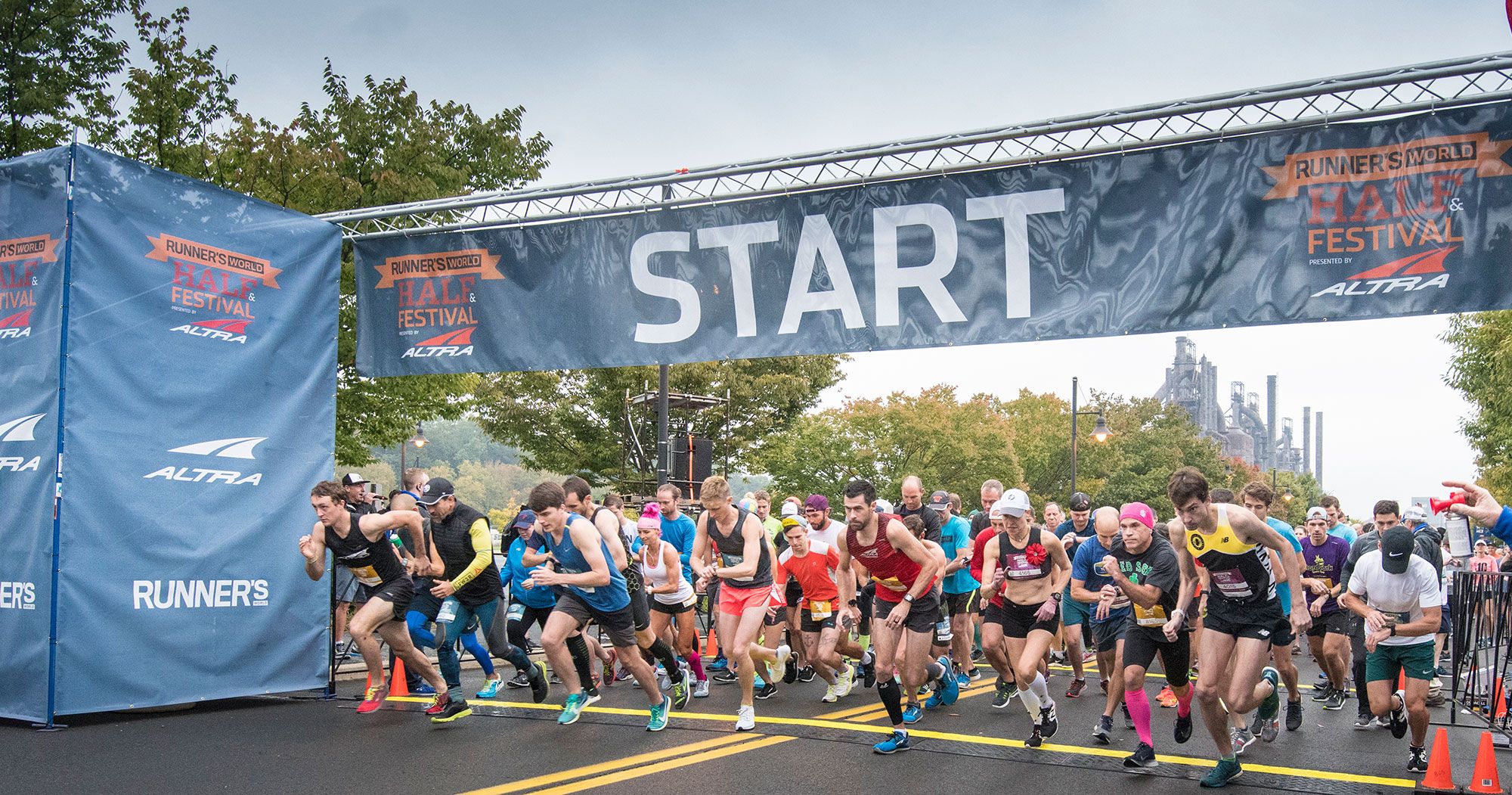

Featured
How To Pace Yourself For A 5K Run
Modified: August 21, 2023
Learn how to pace yourself for a 5K run with featured tips and strategies. Find out how to optimize your training and achieve your goals effortlessly.
Introduction
Welcome to the world of running! Whether you are a seasoned athlete looking to improve your performance or a beginner wanting to take your fitness journey to the next level, participating in a 5K run is a fantastic way to challenge yourself and achieve personal goals.
A 5K, which is equivalent to approximately 3.1 miles, is a popular distance among runners of all abilities. It provides an excellent opportunity to test your endurance, push your limits, and experience the thrill of crossing the finish line. However, to ensure a successful and enjoyable race day experience, it is crucial to pace yourself effectively throughout the race.
Pacing yourself means finding a balance between speed and sustainability. It involves maintaining a consistent rhythm and energy level to avoid burning out too quickly and finishing strong. In this article, we will explore various strategies and techniques to help you pace yourself for a 5K run. By following these guidelines, you will be well-prepared to tackle the distance and achieve your desired goals.
Before we delve into the details, it is important to note that pacing yourself is not just about physical fitness; it also involves mental fortitude and strategic planning. It requires discipline, patience, and the ability to listen to your body’s cues. So, let’s get started on this exciting journey of mastering the art of pacing yourself for a 5K run!
Setting Your Goals
Before you lace up your running shoes and hit the pavement, it’s essential to set clear and achievable goals for your 5K run. Setting goals will not only give you something to strive for but also provide a sense of direction and motivation throughout your training journey.
When setting your goals, it’s important to take various factors into consideration. Are you a beginner aiming to complete your first 5K, or are you an experienced runner aiming for a personal record? Understanding your current fitness level and capabilities will help you establish realistic and attainable goals.
Consider setting both short-term and long-term goals. Short-term goals can be focused on improving your running endurance, increasing your pace, or completing a certain distance without walking. Long-term goals can involve achieving a specific finish time or participating in multiple 5K races throughout the year.
Make sure your goals are specific, measurable, attainable, relevant, and time-bound (SMART). For example, instead of having a vague goal of “getting faster,” you can set a specific goal of improving your 5K time by 1 minute within the next three months. This provides a clear target and timeframe to work towards.
Remember, goal setting is a personal process, so what works for someone else may not work for you. Consider your own abilities, lifestyle, and commitments when establishing your goals. Don’t be afraid to dream big, but also be realistic and set yourself up for success.
Writing down your goals and keeping track of your progress can be highly beneficial. It helps to create a visual representation of your journey and serves as a reminder of what you’re working towards. Additionally, regularly revisiting and evaluating your goals allows you to stay accountable and make any necessary adjustments to your training plan.
Setting your goals is the first step in pacing yourself effectively for a 5K run. It provides the foundation for your training plan and gives you a clear focus. So take some time to reflect on what you want to achieve, and let your goals guide you on this exciting running journey!
Creating a Training Schedule
Now that you have set your goals, it’s time to create a training schedule that will help you progress steadily towards your 5K race. A well-structured training plan is essential for building endurance, improving your running performance, and ensuring you’re adequately prepared for the race day.
When creating your training schedule, consider the amount of time you have available for training each week and your current fitness level. It’s important to strike a balance between challenging yourself and allowing enough time for rest and recovery.
Begin by determining the number of days per week you can commit to running. If you’re a beginner, it’s recommended to start with three or four days of running per week. As you gain experience and build up your endurance, you can gradually increase the number of training days.
Next, establish a balance between running and cross-training activities. While running is the primary focus, incorporating cross-training exercises such as cycling, swimming, or strength training can help improve overall fitness and prevent injury. Aim for at least one or two days of cross-training each week.
Within each week of your training schedule, include a variety of run types to target different aspects of your running fitness. This can include long runs, tempo runs, interval training, and easy/recovery runs. Each run type serves a specific purpose in improving your endurance, speed, and recovery.
Gradually increase your weekly mileage and duration of runs to build up your stamina. However, it’s crucial to increase your mileage gradually to avoid overuse injuries. As a general rule, aim for no more than a 10% increase in mileage per week.
Additionally, don’t forget to incorporate rest days into your training schedule. Rest days are just as important as training days as they allow your body to recover and repair. Use these days to focus on stretching, foam rolling, and engaging in low-impact activities.
Keep in mind that everyone’s training schedule will look different based on individual goals, fitness levels, and time constraints. It’s essential to customize your training plan to suit your needs and listen to your body throughout the process.
By creating a well-rounded training schedule and sticking to it, you’ll gradually improve your fitness, enhance your running performance, and be better prepared to pace yourself effectively for your 5K race.
Warming Up and Cooling Down Techniques
Warming up and cooling down are often overlooked aspects of a training routine, but they play a crucial role in a runner’s overall performance and injury prevention. Incorporating effective warm-up and cool-down techniques into your training routine can help prepare your body for the demands of running and aid in the recovery process.
Before you start your training or participate in a 5K race, it’s essential to warm up your muscles and elevate your heart rate. A proper warm-up routine allows for increased blood flow, improved flexibility, and enhanced muscle activation. It helps to gradually prepare your body for the physical demands of running and reduces the risk of injuries.
A dynamic warm-up routine includes movements that mimic the actions and range of motion used during running. This can include exercises such as light jogging, high knees, butt kicks, leg swings, lunges, and arm circles. Start with lighter movements and gradually increase the intensity to get your muscles and joints warmed up.
Performing dynamic stretches for key muscle groups, such as calves, hamstrings, quadriceps, and hip flexors, can also help improve your range of motion and prevent muscle strains. Hold each stretch for about 15-30 seconds without bouncing, and remember to breathe deeply throughout.
After completing your training session or 5K race, don’t neglect the importance of cooling down. Cooling down allows your heart rate and breathing to gradually return to normal and helps flush out waste products from your muscles.
A proper cool-down routine typically involves light aerobic exercises, such as brisk walking or slow jogging, followed by static stretching. This helps to prevent stiffness, reduce muscle soreness, and promote flexibility. Be sure to stretch major muscle groups, paying particular attention to tight areas.
Static stretches involve holding a stretch position for an extended period, typically 20-30 seconds. Focus on stretching your calves, hamstrings, quadriceps, hip flexors, and glutes. Remember to breathe deeply, relax into each stretch, and avoid bouncing or jerking movements.
Alongside dynamic warm-ups and static stretches, consider incorporating foam rolling and self-myofascial release techniques into your routine. Foam rolling can help release tension and improve circulation in your muscles. Spend a few minutes targeting key areas, such as your calves, quadriceps, IT bands, and glutes.
By incorporating effective warming up and cooling down techniques into your training routine, you’ll enhance blood flow and prepare your muscles and joints for the physical demands of running. Additionally, proper cool-down practices can aid in the recovery process and reduce post-exercise soreness, allowing you to perform at your best and stay injury-free.
Choosing the Right Running Pace
One of the key elements in pacing yourself for a 5K run is choosing the right running pace. Your pace will determine how fast you cover the distance and how well you can sustain your energy throughout the race.
To find your ideal running pace, it’s important to assess your current fitness level and set realistic expectations. If you’re a beginner or aiming to complete your first 5K, starting with a comfortable and conversational pace is recommended. This pace allows you to maintain a steady breathing pattern and hold a conversation while running.
If you have a specific finish time goal in mind, you can use a running pace calculator to determine the pace required to achieve that goal. These calculators consider factors such as your current fitness level, target finish time, and the distance you’re running to provide a recommended pace.
Another method to identify your pace is to use the talk test. During a run, if you can speak comfortably without gasping for air, you are likely running at an appropriate pace. If you find it difficult to complete a sentence without gasping for air, you may be running too fast and should consider slowing down.
It’s important to remember that the right running pace is subjective and varies for each individual. Factors such as age, fitness level, experience, and overall health can influence your ideal pace. Don’t compare yourself to others and focus on running at a pace that feels comfortable and sustainable for you.
During the actual race, it’s common for adrenaline to kick in and tempt you to start faster than your desired pace. However, resist the urge to sprint at the beginning. Start at a conservative pace that allows you to settle into a rhythm and maintain energy for the duration of the race.
Listening to your body is crucial in choosing and maintaining the right running pace. Pay attention to your breathing, heart rate, and overall comfort level. If you feel like you’re pushing too hard or struggling to maintain your pace, it may be necessary to slow down slightly.
Remember, pacing yourself is about finding a balance between pushing your limits and avoiding exhaustion. With practice and experience, you will become better at gauging your pace and making adjustments as needed.
Ultimately, choosing the right running pace comes down to finding what works best for you. Experiment with different paces during your training runs, listen to your body’s feedback, and trust your instincts. Finding your sweet spot will allow you to maintain a strong and steady pace throughout the 5K run.
Building Endurance and Stamina
Building endurance and stamina is crucial for successfully pacing yourself during a 5K run. By gradually improving your cardiovascular fitness and muscular endurance, you’ll be able to maintain a consistent pace and finish the race strong.
Endurance training involves gradually increasing the duration and intensity of your runs over time. Here are some strategies to help you build endurance and stamina:
- Long Runs: Incorporate a weekly long run into your training schedule. Start with a comfortable distance and gradually increase the mileage each week.
- Progressive Runs: Include progression runs in your training. Start at an easy pace and gradually increase your speed throughout the run. This helps train your body to maintain a faster pace over longer distances.
- Hill Training: Incorporate hill repeats or hill workouts into your routine. Running uphill challenges your cardiovascular system and strengthens your leg muscles, improving overall endurance and stamina.
- Interval Training: Integrate interval training sessions into your training plan. Alternate between periods of high-intensity running, such as sprints, and recovery periods. This helps to improve cardiovascular fitness and increase your tolerance for higher speeds.
- Tempo Runs: Implement tempo runs, also known as lactate threshold runs, into your training. These runs involve maintaining a comfortably hard pace for an extended period. Tempo runs help improve your body’s ability to clear lactic acid, which results in increased endurance.
- Consistency: Consistency is key when it comes to building endurance. Stick to your training plan and avoid skipping or shortening runs. Gradually increase your weekly mileage and make running a regular habit.
It’s important to note that building endurance takes time. Be patient and allow your body to adapt to the increased training load gradually. Avoid the temptation to push too hard too soon, as this can lead to overuse injuries or burnout.
Remember to listen to your body and take rest days as needed. Recovery is a crucial component of building endurance. It allows your muscles to repair and rebuild, ensuring you’re ready for the next training session.
In addition to running, cross-training activities such as cycling, swimming, or using an elliptical machine can also be beneficial for building endurance. These low-impact exercises provide cardiovascular benefits while giving your running muscles a break.
By consistently incorporating endurance-building strategies into your training plan and allowing for proper recovery, you’ll improve your overall stamina and be better equipped to pace yourself effectively during the 5K run.
Incorporating Interval Training
Interval training is a highly effective method for improving your speed, endurance, and overall race pace. By incorporating interval training into your 5K training plan, you can push your limits, increase your cardiovascular fitness, and enhance your ability to maintain a faster pace for longer durations.
Interval training involves alternating between periods of high-intensity effort and recovery. This type of training challenges your body’s cardiovascular system, stimulates greater oxygen uptake, and improves your body’s ability to clear lactic acid buildup.
Here are a few key points to keep in mind when incorporating interval training:
- Choose Appropriate Intervals: Select intervals that match your fitness level and goals. For shorter intervals, aim for higher intensities, such as sprinting or running close to your maximum effort. For longer intervals, aim for a slightly less intense but sustainable pace.
- Start with a Warm-Up: Begin each interval session with a proper warm-up to gradually increase your heart rate and loosen up your muscles. This can include light jogging, dynamic stretches, or drills to prepare your body for the intense workout ahead.
- Set a Work-to-Rest Ratio: Determine the ratio of work (high-intensity effort) to rest (recovery period) based on your fitness level and goals. A common interval ratio for 5K training is 1:1 or 1:2 (e.g., 30 seconds of sprinting followed by 30 seconds or 1 minute of recovery). Experiment to find the ratio that works best for you.
- Keep Proper Form and Technique: During high-intensity intervals, maintain good running form to maximize efficiency and reduce the risk of injury. Focus on your posture, arm swing, and stride length. Avoid excessive tension and unnecessary movements.
- Gradually Increase Intensity and Duration: Start with shorter interval sessions and gradually increase both the intensity and duration as your fitness level improves. Add more intervals or increase the distance or time of each interval as you progress.
- Allow for Proper Recovery: Rest and recovery are just as important as the high-intensity intervals. Give yourself enough time to recover between intervals to maintain the quality of each repetition. This will help prevent overexertion and reduce the risk of overuse injuries.
- Combine Interval Training with Other Running Workouts: Interval training should be incorporated in conjunction with other types of training, such as long runs, tempo runs, and easy runs, to create a well-rounded training plan. This variety will help improve different elements of your running performance.
Remember, interval training is challenging, so it’s important to listen to your body and adjust the intensity and duration of your intervals as needed. Don’t be discouraged if you can’t maintain the same pace for each interval initially – it takes time and practice to improve.
Incorporating interval training into your 5K training plan will not only help you improve your speed but also enhance your overall fitness and race performance. Stay consistent, stay persistent, and reap the rewards of this high-intensity training method.
Listening to Your Body
When it comes to pacing yourself for a 5K run, one of the most important factors is listening to your body. Your body provides valuable feedback, both during training and on race day, that can guide you in making adjustments to your pace and effort level.
Here are some key points to consider when it comes to listening to your body:
- Pain and Discomfort: Pay attention to any signs of pain or discomfort during your training runs. It’s important to understand the difference between normal exercise discomfort and potential injury. If you experience persistent pain or a sharp, intense pain, it’s advisable to consult with a medical professional.
- Breathing: Monitor your breathing pattern during your runs. It’s essential to find a pace and effort level that allows you to maintain a regular and comfortable breathing rhythm. If you find yourself gasping for air or struggling to catch your breath, it may be an indication that you’re pushing too hard and should slow down.
- Fatigue: Listen to your body’s signals of fatigue. It’s normal to feel tired during and after a challenging run, but excessive fatigue or a general feeling of sluggishness can be a sign of overtraining or inadequate rest and recovery. Take rest days as needed and ensure you’re getting sufficient sleep and nutrition to support your training.
- Muscle Soreness: Muscle soreness is common after intense workouts, including running. However, if you experience severe or prolonged muscle soreness, it may be an indication of overuse or injury. Give your body time to recover, incorporate proper warm-ups and cool-downs, and consider adding cross-training and rest days to your training plan.
- Mental State: Pay attention to your mental state during your runs. Running is not just a physical activity; it also has a psychological aspect. Be aware of any signs of mental fatigue or burnout, such as a lack of motivation or negative thoughts. Take steps to address these issues, such as adjusting your training schedule, incorporating variety into your runs, or seeking support from a running partner or coach.
- Adapting to Changing Conditions: Be flexible and adapt your pace and effort level based on the external conditions. Factors such as weather, terrain, and elevation can significantly impact your performance. Adjust your expectations and be prepared to modify your pace accordingly to ensure a safe and enjoyable run.
Listening to your body requires self-awareness, mindfulness, and a willingness to make adjustments when necessary. By paying attention to these physical and mental cues, you can make informed decisions about your pace, effort level, and overall running experience.
Remember, every runner is unique, and what works for someone else may not work for you. Trust your instincts, be kind to your body, and find a pace that allows you to perform at your best while maintaining a sense of comfort and enjoyment.
Staying Consistent with Your Training
Consistency is a key factor in pacing yourself effectively for a 5K run. Following a consistent training plan allows you to build your endurance, improve your running performance, and develop the mental and physical discipline needed for race day. Here are some tips to help you stay consistent with your training:
- Create a Training Schedule: Establish a weekly training schedule that includes specific days and times for your runs. Having a plan in place will help you stay organized and committed to your training.
- Stick to Your Plan: Once you have a training schedule, make a commitment to stick to it as closely as possible. Of course, life can sometimes get in the way, but prioritize your training and make it a non-negotiable part of your routine.
- Gradually Increase Your Mileage: Gradually increase your training mileage over time. Adding too much distance too quickly can lead to overuse injuries. Aim for a 10% increase in mileage each week to allow your body to adapt and recover adequately.
- Find an Accountability Partner: Running with a friend or joining a running group can provide accountability and motivation. Knowing you have someone to train with or meet for a run can help you stay committed to your training plan.
- Track Your Progress: Keep a training journal or use a running app to track your progress. Record details of each run, including distance, pace, and how you felt during the run. Seeing your progress on paper or in an app can be highly motivating and help you stay consistent.
- Mix Up Your Runs: Avoid falling into a training rut by incorporating variety into your runs. Include different types of runs, such as interval training, tempo runs, and long runs, to keep your workouts interesting and challenging. This will also help prevent mental and physical burnout.
- Listen to Your Body: Pay attention to any signs of fatigue, pain, or excessive soreness. It’s important to allow your body time to rest and recover when needed. Pushing through fatigue or running through pain can lead to injuries and setbacks.
- Stay Motivated: Find ways to stay motivated throughout your training. Set small goals, reward yourself after completing milestones, or participate in virtual races to keep your motivation levels high. Remember why you started and visualize crossing that finish line on race day.
- Be Flexible: While consistency is important, it’s also crucial to be flexible and adaptable. Life happens, and sometimes unexpected events or circumstances may require adjustments to your training schedule. Be willing to make modifications when necessary, but always prioritize your training.
Consistency is the backbone of successful training. By sticking to your training plan, gradually increasing your mileage, and listening to your body, you’ll build the physical and mental endurance needed to pace yourself effectively during a 5K run. Stay committed, stay focused, and enjoy the journey!
Proper Nutrition and Hydration
Proper nutrition and hydration play a vital role in your overall performance and ability to pace yourself during a 5K run. Fueling your body with the right nutrients and maintaining proper hydration levels will ensure that you have the energy and stamina to conquer the race. Here are some tips for proper nutrition and hydration:
- Eat a Balanced Diet: Consume a well-balanced diet that includes a variety of whole foods. Focus on incorporating lean proteins, complex carbohydrates, healthy fats, and plenty of fruits and vegetables into your meals. These provide essential nutrients and energy for optimal performance.
- Timing is Key: Pay attention to your pre-run and post-run meals. Before a training session or the race, aim to eat a balanced meal that includes easily digestible carbohydrates and some protein about two to three hours beforehand. Afterward, replenish your body with a combination of carbs and protein within 30-60 minutes to aid in muscle recovery.
- Stay Hydrated: Hydration is crucial before, during, and after your runs. Make sure to drink enough water throughout the day to maintain proper hydration levels. During your runs, consume water or a sports drink to replenish lost fluids and electrolytes. Listen to your body’s thirst cues and adjust your intake accordingly.
- Consider Electrolytes: In addition to staying hydrated, it’s important to replenish electrolytes, especially during longer or more intense training sessions. Electrolytes help maintain the balance of fluids in your body and support proper muscle function. Consider consuming electrolyte-rich foods or drinks, or using electrolyte supplements as needed.
- Experiment during Training: Use your training runs as an opportunity to experiment with different nutrition and hydration strategies. Everyone’s body is unique, so figure out what works best for you. Test different foods, drinks, and timing to find the combinations that provide optimal performance and minimize digestive discomfort.
- Avoid Trying Anything New on Race Day: Stick to what you know works for you as far as nutrition and hydration on race day. Trying new foods, drinks, or supplements can lead to digestive issues or discomfort, which can negatively impact your performance. Stick with the fueling plan you’ve tested during your training runs.
- Recover Properly: After your training runs, pay attention to your post-run nutrition to support recovery. Consuming a combination of carbohydrates and protein within 30-60 minutes helps replenish glycogen stores and promotes muscle repair.
- Get Adequate Sleep: Sleep plays a crucial role in your overall health and performance. Make sure to prioritize quality sleep to allow your body to recover and recharge. Aim for seven to nine hours of sleep each night.
- Listen to Your Body: Finally, listen to your body’s hunger and satiety cues. Everyone’s nutritional needs are different, so eat when you’re hungry and stop when you’re satisfied. Learn to differentiate between emotional and physical hunger to maintain a healthy relationship with food.
Proper nutrition and hydration are essential components of successful race preparation. Experiment with different strategies during training, find what works best for you, and stick to it on race day. By fueling your body with the right nutrients and staying properly hydrated, you’ll have the energy and endurance needed to pace yourself effectively during the 5K run.
Breathing Techniques
Breathing is an often overlooked aspect of running, but it plays a crucial role in your performance and ability to pace yourself during a 5K run. Proper breathing techniques can help improve your oxygen intake, optimize your running efficiency, and enhance your overall running experience. Here are some tips for mastering your breathing:
- Find Your Rhythm: Pay attention to your natural breathing rhythm and find a pattern that works for you. Some runners find it helpful to sync their breathing with their strides, such as inhaling for two strides and exhaling for two strides.
- Diaphragmatic Breathing: Practice diaphragmatic breathing, also known as belly breathing or deep breathing. This involves taking slow, deep breaths that expand your belly instead of shallow chest breaths. Diaphragmatic breathing allows for maximum oxygen intake and promotes relaxation while running.
- Focus on Exhalation: Place emphasis on slow and complete exhalation during your runs. Fully expelling the air from your lungs allows for better oxygen exchange when you inhale, ensuring a steady flow of fresh oxygen into your body.
- Breathe Through Your Nose and Mouth: While running, aim to breathe through both your nose and mouth to maximize oxygen intake. Breathing through your nose filters and warms the air, while breathing through your mouth allows for greater air volume exchange.
- Control Your Breathing: Maintain control of your breathing by focusing on steady and relaxed inhalations and exhalations. Avoid rapid or shallow breathing, as it can lead to hyperventilation and an imbalance in carbon dioxide levels.
- Match Breathing to Effort Level: Adjust your breathing pattern to match your effort level. When running at an easy pace or during recovery periods, aim for a relaxed and comfortable breathing pattern. As the intensity increases, you may naturally take deeper or quicker breaths.
- Practice Breath Control Exercises: Incorporate breath control exercises into your training routine to improve lung capacity and breath control. For example, you can try interval training with breath holds, where you hold your breath for a few seconds during steady efforts and then recover with normal breathing.
- Relax and Stay Mindful: Stay relaxed and mindful of your breathing during your runs. Avoid tensing up your neck, shoulders, or chest, as it can restrict your breathing. Focus on maintaining a relaxed and rhythmic breathing pattern, allowing your body to find its natural rhythm.
- Practice Outside of Running: Incorporate breathing exercises into your daily life to improve your overall lung capacity and breath control. Yoga, meditation, and deep breathing exercises can all help enhance your ability to breathe effectively during your runs.
- Experiment and Find What Works for You: Remember that every runner is different, and what works for one person may not work for another. Experiment with different breathing techniques during your training runs, and pay attention to how each approach affects your running performance and comfort level.
By incorporating proper breathing techniques into your running routine, you can optimize your oxygen intake, increase your running efficiency, and maintain a consistent pace. Practice and experiment with different techniques to find what works best for you. With time and experience, you’ll develop a natural and effective breathing rhythm to help you pace yourself effectively during your 5K run.
Mental Preparation
Mental preparation is just as important as physical training when it comes to pacing yourself for a 5K run. Developing mental fortitude and employing effective strategies can help you maintain focus, stay motivated, and push through any challenges you may encounter along the way. Here are some tips for mental preparation:
- Set Positive and Realistic Mindset: Start by setting a positive and realistic mindset. Believe in your ability to reach your goals and visualize yourself successfully pacing yourself during the 5K run. Replace negative thoughts with positive affirmations, and remind yourself of your progress and accomplishments.
- Break the Distance Down: Instead of focusing on the full 5K distance, break it down into smaller, more manageable segments. Set mini-goals for each mile or kilometer. This helps make the distance feel less daunting and allows you to concentrate on one step at a time.
- Practice Visualization: Use visualization techniques to imagine yourself running smoothly, maintaining a steady pace, and crossing the finish line with strength and confidence. Visualize yourself overcoming obstacles and pushing through any challenges that may arise.
- Develop Mantras or Affirmations: Create personalized mantras or affirmations that resonate with you. Repeat these positive statements to yourself during your training runs and on race day. Your mantras can help you stay focused, motivated, and remind you of your inner strength.
- Utilize Distraction Techniques: Employ distraction techniques to keep your mind engaged and focused during the run. This can include listening to music, podcasts, or audiobooks, focusing on your surroundings, or mentally reciting affirmations or motivational quotes.
- Practice Mindfulness: Engage in mindfulness techniques to stay present and centered during your runs. Pay attention to your breathing, the rhythm of your footsteps, and the sensations in your body. This encourages a sense of flow and helps you let go of concerns about pace or performance.
- Prepare for Race Day Challenges: Anticipate potential race day challenges, such as fatigue, discomfort, or negative thoughts, and develop strategies to overcome them. For example, visualize yourself pushing through fatigue or create a mantra to repeat when facing tough moments.
- Draw Inspiration from Others: Find inspiration and motivation from the stories of other runners, both elite athletes and everyday enthusiasts. Surround yourself with a supportive community of runners who can share experiences, provide encouragement, and celebrate your progress.
- Reflect on your Training: Remind yourself of the hard work and dedication you’ve put into your training. Reflect on the progress you’ve made and the obstacles you’ve overcome. Building confidence in your training will boost your belief in your ability to pace yourself during the 5K run.
- Enjoy the Journey: Lastly, remember to enjoy the journey. Embrace the experience of training for a 5K run and the sense of accomplishment that comes with it. Focus on the process rather than solely the outcome, and savor each step of the way.
Mental preparation is a powerful tool in pacing yourself for a 5K run. By developing a positive mindset, utilizing visualization and affirmation techniques, and staying present in the moment, you can enhance your overall running experience and perform at your best on race day.
Final Tips and Recommendations
As you continue to prepare for your 5K run and work on pacing yourself effectively, here are some final tips and recommendations to keep in mind:
- Practice Race-Day Conditions: Incorporate some training runs that mimic race-day conditions, such as running at a similar time of day, on similar terrain, or in similar weather conditions. This will help familiarize yourself with potential challenges and allow you to make any necessary adjustments to your pacing strategy.
- Don’t Neglect Strength Training: In addition to your running workouts, include strength training exercises in your routine. Strengthening your legs, core, and upper body can improve running economy, stability, and overall performance.
- Take Rest Seriously: Don’t underestimate the importance of rest and recovery. Allow your body time to recover and adapt to the demands of training. Proper rest will help prevent injuries and improve your overall performance.
- Get Proper Gear: Invest in a good pair of running shoes that provide the necessary support and cushioning for your feet. Wear moisture-wicking and comfortable clothing that allows for freedom of movement. Having the right gear can enhance your comfort and running experience.
- Listen to Your Coach or Trainer: If you’re working with a running coach or trainer, listen to their guidance and follow their recommendations. They have the expertise and experience to help you reach your goals and pace yourself effectively.
- Have a Race Plan: Develop a race plan that includes pacing milestones, hydration strategies, and mental tactics. Having a plan in place will help you stay focused and make adjustments as needed during the race.
- Trust Your Training: Have confidence in your training and the progress you’ve made. Trust that the work you’ve put in will pay off on race day. Trusting your training will help alleviate pre-race nerves and allow you to stay calm and focused.
- Stay Positive and Have Fun: Remember to stay positive and enjoy the journey. Embrace any challenges that come your way and remember that a positive mindset can make a significant difference. Celebrate your accomplishments, and most importantly, have fun!
- Learn from Each Race: Treat every race, whether it’s a training run or an official event, as a learning opportunity. Reflect on your performance, identify areas for improvement, and adjust your training plan accordingly. Each race is a stepping stone towards becoming a better and more efficient runner.
- Celebrate Your Achievement: Finally, once you cross that finish line, take a moment to celebrate your achievement. Acknowledge the hard work, dedication, and effort you’ve put into your training. Be proud of yourself and use this experience as fuel for future goals and challenges.
Pacing yourself for a 5K run requires patience, discipline, and a commitment to both physical and mental preparation. By incorporating these final tips and recommendations into your training, you’ll be well-equipped to approach the race with confidence, positivity, and the ability to pace yourself effectively.
Conclusion
Congratulations! You have now gained a comprehensive understanding of pacing yourself for a 5K run. Through setting goals, creating a training schedule, practicing proper warm-up and cool-down techniques, choosing the right running pace, building endurance and incorporating interval training, listening to your body, maintaining consistency, focusing on proper nutrition and hydration, utilizing effective breathing techniques, engaging in mental preparation, and implementing final tips and recommendations, you are well-prepared to tackle your 5K race with confidence and success.
Remember, pacing yourself is a balance between pushing your limits and listening to your body’s cues. Stay consistent with your training, adapt to changing conditions, and trust in your preparation. Embrace the mental and physical challenges that come with the journey, and have faith in your ability to overcome them.
Whether you are a seasoned runner or a beginner embarking on your very first 5K run, the key is to enjoy the process, celebrate your achievements, and have fun along the way. You’ve put in the hard work and dedication, and now it’s time to shine on race day. Lace up your running shoes, take a deep breath, and let the experience of pacing yourself for a 5K run propel you towards new heights in your running journey.









